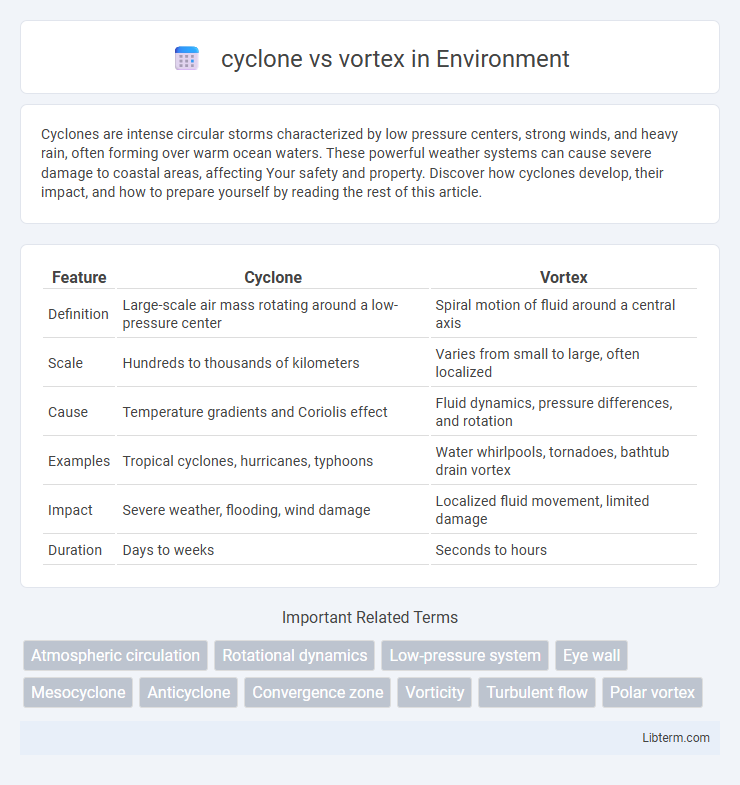Cyclones are intense circular storms characterized by low pressure centers, strong winds, and heavy rain, often forming over warm ocean waters. These powerful weather systems can cause severe damage to coastal areas, affecting Your safety and property. Discover how cyclones develop, their impact, and how to prepare yourself by reading the rest of this article.
Table of Comparison
| Feature | Cyclone | Vortex |
|---|---|---|
| Definition | Large-scale air mass rotating around a low-pressure center | Spiral motion of fluid around a central axis |
| Scale | Hundreds to thousands of kilometers | Varies from small to large, often localized |
| Cause | Temperature gradients and Coriolis effect | Fluid dynamics, pressure differences, and rotation |
| Examples | Tropical cyclones, hurricanes, typhoons | Water whirlpools, tornadoes, bathtub drain vortex |
| Impact | Severe weather, flooding, wind damage | Localized fluid movement, limited damage |
| Duration | Days to weeks | Seconds to hours |
Introduction to Cyclones and Vortices
Cyclones and vortices are rotating fluid phenomena characterized by circular motion around a central axis, with cyclones being large-scale low-pressure weather systems that form over oceans and generate strong winds and heavy rain. Vortices appear in various scales and contexts, including atmospheric tornadoes, water whirlpools, and engineered flows, defined by their spinning motion and pressure gradients. Understanding the dynamics of cyclones involves meteorology and thermodynamics, while vortices encompass broader fluid mechanics principles across different environments.
Defining Cyclone: Key Characteristics
A cyclone is a large-scale atmospheric system characterized by a low-pressure center and rotating winds that move counterclockwise in the Northern Hemisphere and clockwise in the Southern Hemisphere. Key characteristics include strong winds, heavy rainfall, and a well-defined eye at the center, where the lowest pressure is found. Unlike generic vortices, cyclones involve organized weather patterns impacting vast areas with significant intensity and duration.
Understanding Vortex: Core Concepts
A vortex is a fluid flow pattern characterized by a rotating motion around a central axis, where the velocity is highest near the core and decreases outward. Understanding the core concepts of a vortex involves analyzing factors like circulation, vorticity, and pressure gradients that maintain the spinning motion and influence stability. Unlike cyclones, which are large-scale atmospheric vortices driven by pressure systems and Earth's rotation, vortices can occur in various scales and mediums, including water, air, and plasmas.
Types of Cyclones Explained
Tropical cyclones form over warm ocean waters and are characterized by intense winds and heavy rain, commonly known as hurricanes or typhoons depending on the region. Extratropical cyclones develop in mid-latitudes from temperature contrasts between air masses and often bring storms and strong winds. Mesocyclones are smaller rotating air masses within severe thunderstorms, frequently associated with tornado formation.
Common Forms of Vortices
Common forms of vortices include cyclones, tornadoes, and whirlpools, each characterized by rotating fluid motion around a core of low pressure. Cyclones are large-scale air mass rotations with diameters ranging from hundreds to thousands of kilometers, predominantly observed in tropical and extratropical regions. Smaller vortices like tornadoes exhibit concentrated, intense rotational winds, while whirlpools occur in water bodies, demonstrating the universality of vortex dynamics across different fluid environments.
Formation Mechanisms: Cyclone vs Vortex
Cyclones form through large-scale atmospheric pressure differences, where warm, moist air rises and creates a rotating system around a low-pressure center driven by the Coriolis effect. Vortices arise from fluid dynamics in various contexts, generated by velocity gradients causing rotational motion in gases or liquids, independent of atmospheric phenomena. Understanding the distinct formation mechanisms highlights that cyclones are specific meteorological vortices with organized structure, while vortices encompass a broader range of rotating fluid patterns.
Physical Structure Comparison
A cyclone is a large-scale atmospheric system characterized by a low-pressure center with spiraling winds rotating counterclockwise in the Northern Hemisphere and clockwise in the Southern Hemisphere, typically spanning hundreds of kilometers. A vortex, in contrast, is a broader fluid dynamics phenomenon involving a rotating flow of fluid around a central axis, which can occur at various scales, from small whirlpools to tornadoes and cyclones. The physical structure of a cyclone includes organized cloud bands and a defined eye, whereas a vortex generally emphasizes the rotational movement of fluid without necessarily exhibiting the extensive, organized meteorological features of a cyclone.
Impact and Effects: Cyclone vs Vortex
Cyclones generate extensive damage due to high-speed winds, heavy rainfall, and storm surges, leading to flooding, infrastructure destruction, and loss of life over large geographic areas. Vortices, such as tornadoes or dust devils, produce localized but intense impacts including extreme wind damage, debris scattering, and sudden pressure drops affecting smaller regions. The scale and duration of cyclones typically result in widespread socio-economic disruption, whereas vortices cause rapid, focused destruction with shorter temporal effects.
Real-World Examples and Case Studies
Cyclone Bhola (1970) exemplifies a devastating tropical cyclone, characterized by intense low-pressure systems with powerful winds and heavy rainfall forming over warm ocean waters. In contrast, the Icelandic vortex demonstrates atmospheric vortex behavior, featuring cold-core low-pressure systems spinning over land or cold ocean regions, often causing localized weather disruptions rather than widespread destruction. Case studies of Cyclone Bhola highlight extensive storm surges and humanitarian impacts, while analyses of polar vortices reveal their role in extreme cold outbreaks and stratospheric ozone depletion events.
Conclusion: Key Differences and Similarities
Cyclones and vortices both involve rotating air masses but differ primarily in scale and formation; cyclones are large-scale weather systems associated with low-pressure centers, while vortices can be small, localized spinning air patterns. Both phenomena exhibit circular motion due to Coriolis force or pressure gradients, influencing weather and fluid dynamics. Understanding these distinctions is crucial for meteorology and atmospheric science applications.
cyclone Infographic

 libterm.com
libterm.com